The relationship of longitudinal cognitive change to self-reported IADL in a general population
- PMID: 30915889
- PMCID: PMC6764909
- DOI: 10.1080/13825585.2019.1597008
The relationship of longitudinal cognitive change to self-reported IADL in a general population
Abstract
This study examined the relationship between cognitive change and instrumental activities of daily living (IADL) in a large, national, population-based sample. Cognitive change was assessed via verbal fluency, word list learning (WLL), and word list delayed recall (WLD). Incident cognitive impairment was defined by change in Six-Item Screener (SIS) status over a period of 10 years. Impaired IADL was defined as self-reported difficulty or needing assistance performing any IADL at Year 10. A one-word decrease in WLL over a 10-year span increased the odds of impaired IADL by 16% (95% CI 1.08-1.24) and incident cognitive impairment increased the odds of impaired IADL by 59% (95% CI 1.36-1.85) when adjusting for demographic factors, health-related behaviors, vascular risk factors and disease, and depressive symptoms. Cognitive change most strongly predicted impairment in managing finances (OR 2.47, 95% CI 2.04-3.00) and driving (OR 2.06, 95% CI 1.73-2.44).
Keywords: Cognitive aging; depression; instrumental activities of daily living; longitudinal studies; stroke.
Conflict of interest statement
Figures

References
-
- Alzheimer’s A (2015). 2015 Alzheimer’s disease facts and figures. Alzheimers Dement, 11(3), 332–384. - PubMed
-
- Andresen EM, Malmgren JA, Carter WB, & Patrick DL (1994). Screening for Depression in Well Older Adults: Evaluation of. Prev Med, 10, 77–84. - PubMed
-
- Barberger-Gateau P, Commenges D, Gagnon M, Letenneur L, Sauvel C, & Dartigues JF (1992). Instrumental activities of daily living as a screening tool for cognitive impairment and dementia in elderly community dwellers. J Am Geriatr Soc, 40(11), 1129–1134. - PubMed
Publication types
MeSH terms
Grants and funding
LinkOut - more resources
Full Text Sources
Medical
